Science & Technology - 2018
April
From Virtual Worlds to Augmented Reality
Spring Facility Maintenance Period Completed
NIF Photos Featured in ‘Art of Science’ Exhibit
Lasers, Photonics, and Powerful Partnerships
The world’s highest-energy laser sits in a secure, guarded federal laboratory, but its impact stretches far beyond the one-square-mile site of Lawrence Livermore National Laboratory. Since the outset, technologies developed or improved at the Laboratory have led to industry-defining partnerships and products that make millions of Americans’ lives better every day. Even if they’ve never heard of them.
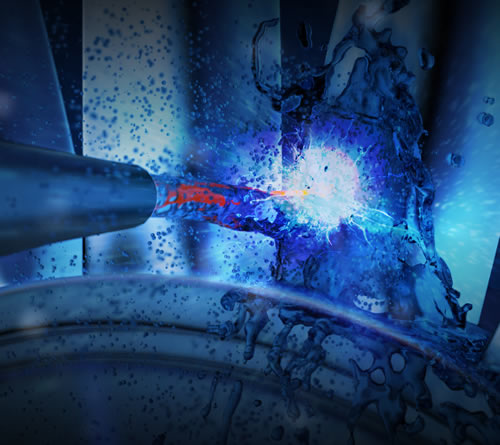 The commercialization of laser peening technology—similar to working a metal’s surface with a ballpeen hammer—has been one of the most successful transfers of Lawrence Livermore technology to industry. The technology, which originated at Battelle Memorial Institute in the 1970s and was first commercialized by LSP Technologies in 1975, was upgraded by Livermore researchers working with Metal Improvement Company.
The commercialization of laser peening technology—similar to working a metal’s surface with a ballpeen hammer—has been one of the most successful transfers of Lawrence Livermore technology to industry. The technology, which originated at Battelle Memorial Institute in the 1970s and was first commercialized by LSP Technologies in 1975, was upgraded by Livermore researchers working with Metal Improvement Company. “Nearly all of us at this point have flown on an airplane with turbine blades that were laser peened with technology that Livermore commercialized years ago,” says Craig Siders, senior scientist and commercial technology development leader in NIF & Photon Science’ Advanced Photon Technologies program. Laser peening—using intense laser light to improve the quality of a material—is commonplace now, thanks in part to Laboratory research that was spun off into the private sector.
Laser peening was invented in the 1970s but had not achieved significant market penetration until LLNL introduced a new laser architecture which provided critical new functionality to the technology. In 2003, former LLNL scientists Lloyd Hackel and Brent Dane, together with LLNL CRADA (cooperative research and development agreement) partner Metal Improvement Company (MIC)—today part of Curtiss-Wright Corporation—helped bring the benefits of laser peening to the economy as a whole.
The Laboratory’s commercialization process worked: Lawrence Livermore helped develop a cutting-edge technology until it was mature enough to stand on its own. Today, MIC’s laser peening can exponentially extend the lifespan of an F-22 fighter jet’s airframe. MIC has treated jet engine fan blades on every Airbus A340 passenger plane and hundreds of Boeing 777s and 787s. It’s the third-best royalty-producing technology in Lab history.
“It’s technology that’s absolutely in the hands of industry today, and the Lab is now out of the peening business, because it’s the right thing to do,” Siders adds. “LLNL’s innovations in laser technology was a critical component in making peening a success story.”
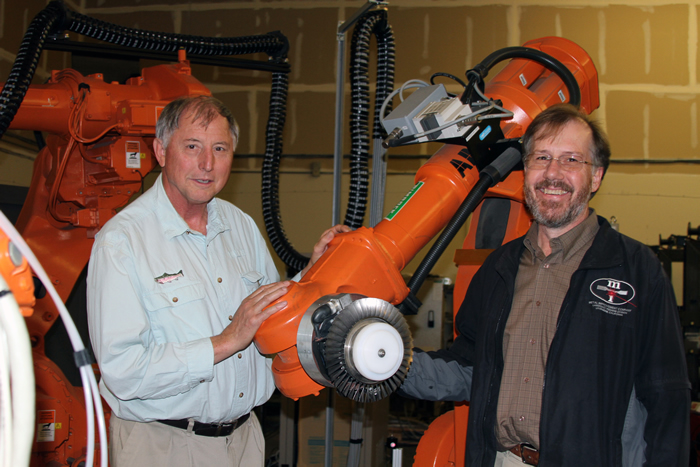 Former LLNL researchers Lloyd Hackel (left) and Brent Dane successfully commercialized an LLNL laser-peening technology and used it to become entrepreneurs at Metal Improvement Company (now an element of Curtiss-Wright Surface Technologies). The men are standing in front of a robot used to peen parts for aviation and other industries at MIC’s Livermore R&D center. Credit: Julie Russell
Former LLNL researchers Lloyd Hackel (left) and Brent Dane successfully commercialized an LLNL laser-peening technology and used it to become entrepreneurs at Metal Improvement Company (now an element of Curtiss-Wright Surface Technologies). The men are standing in front of a robot used to peen parts for aviation and other industries at MIC’s Livermore R&D center. Credit: Julie Russell And now LLNL is offering the opportunity to license and commercialize an extension of laser-peening technology called high velocity laser accelerated deposition (HVLAD) for controlled laser-driven explosive bonding. HVLAD was selected by R&D Magazine as a winner of an R&D 100 Award in 2012.
“We’re in the process of satisfying the primary goals of the Lab: pursuing national security, stockpile stewardship and fundamental science,” says David Dawes, a business development executive in LLNL’s Innovation and Partnerships Office (IPO). “All of these things can help generate spinoffs that are commercially important.”
Dawes is a primary conduit between LLNL and industry. When scientists believe they have made a breakthrough, they often come to Dawes for advice. Whether that conversation leads to a record of invention, a patent, or a CRADA, he’s instrumental in helping keep up with the laser and optics industry and matching research with opportunity. Many of NIF’s 40,000 brand-new, specialized optical components represent commercialization opportunities, thanks to the new technologies developed to create them in the first place. As the Laboratory advances each dimension of laser and optics technology, companies can follow behind and adopt them as they become available.
“All of these features involve leading-edge technologies that are important to the laser industry as a whole as they scale up their power levels,” Dawes says. “There’s marketable technologies there that we’re currently talking to a number of companies about licensing.” For other examples of current laser and optics technologies available for commercialization, see the IPO Website.
In particular, Dawes brings 35 years of experience in the industry (and some patents of his own) to bear on IPO’s work connecting research with companies. Maintaining long-standing relationships with industry and academic leaders, setting up visits to Livermore and monitoring trade and scientific journals are all important tricks of Dawes’ trade. IPO screens every paper slated for journal publication in order to identify possibilities for future commercialization. Details on ongoing CRADAs and licensing are scarce, but the Laboratory’s track record speaks for itself.
“The Lab has had a significant impact, historically, on the market,” says Siders. “There’s a lot of goodwill out there, built up with past success stories like peening.”
Pushing the Frontiers in Lasers
Anticipating the next generation of lasers is especially fertile ground for partnerships with LLNL’s NIF & Photon Science researchers. Scientists expect these lasers to be so powerful, current optics technologies won’t be able to withstand them.
“When I was a professor, I called this the first law of directed energy,” says Siders. “Thou Shalt Destroy the Target Before You Destroy the Laser.”
A current CRADA with Electro-Optics Technology (EOT) aims to address one of these. Known for their diode-like Faraday isolators—permitting light to pass in one direction only while preventing harmful backward propagation—EOT, among other industry leaders, got a call from Laboratory researchers with experience in high-power laser performance and component cooling looking for pushing the limits of isolator technologies. EOT was looking to advance applications of new materials, which fit perfectly into the needs for high-power isolators. Together, EOT and LLNL are close to producing a marketable product that will benefit the laser industry as a whole and prepare the Laboratory for advanced high-power laser systems.
One such system is the new HAPLS pulsed-laser system currently being installed in the European Union’s Extreme Light Infrastructure (ELI) Beamlines facility in the Czech Republic. HAPLS (the High-Repetition-Rate Advanced Petawatt Laser System, designed, developed, and delivered by LLNL) integrates a number of new, efficient, high-power laser and optical technologies that Siders believes will eventually lead to the lasers necessary for inertial fusion energy. It’s a powerful tool for its customer, ELI Beamlines, but it’s also a window for scientists into the future of high-power pulsed lasers and a possible fusion power plant.
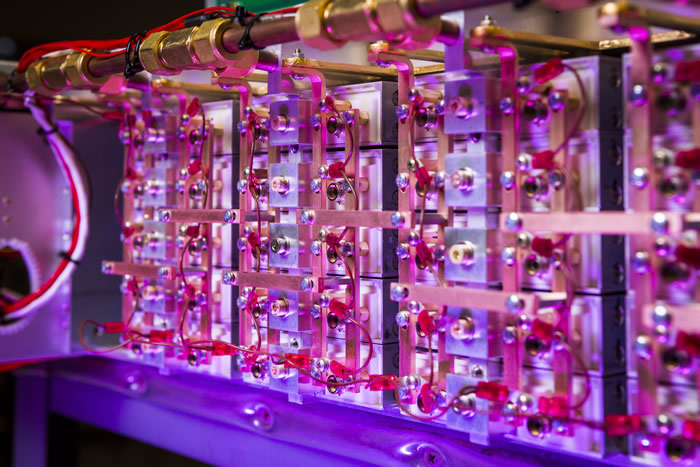 LLNL researchers partnered with Lasertel Inc. to develop the world’s highest peak power laser diode arrays, representing total peak power of 3.2 megawatts, to power the High-Repetition-Rate Advanced Petawatt Laser System (HAPLS). To drive the diode arrays, LLNL developed and patented a completely new type of pulsed-power system, which supplies the arrays with electrical power by drawing energy from the grid and converting it to extremely high-current, precisely-shaped electrical pulses.
LLNL researchers partnered with Lasertel Inc. to develop the world’s highest peak power laser diode arrays, representing total peak power of 3.2 megawatts, to power the High-Repetition-Rate Advanced Petawatt Laser System (HAPLS). To drive the diode arrays, LLNL developed and patented a completely new type of pulsed-power system, which supplies the arrays with electrical power by drawing energy from the grid and converting it to extremely high-current, precisely-shaped electrical pulses. “We’re actually looking to provide benefits back from investments that this nation and the Department of Energy have made over four or five decades of research into inertial confinement fusion and inertial fusion energy,” says Siders. While luck is always a component, he adds that strategy and ongoing communication are key to maintaining fruitful partnerships.
“By working with industry in that way, we can get products on the market that everyone can benefit from,” says Siders. “That helps move the nation’s laser technology capabilities forward. That’s a good news story.”
In addition to the significant benefits Lawrence Livermore’s laser and optics research can provide to industry, commercialization can also have a tremendous impact on the scientists themselves.
“I often tell folks here that there’s a future where they could walk into almost any lab in the world, point to something, and say ‘hey, that’s my work,’” says Siders. “That’s immensely rewarding.”
—Ben Kennedy
From Virtual Worlds to Augmented Reality
The NIF Target Chamber spans 10 meters (roughly 30 feet) in diameter—the size of a small hot-air balloon—with plenty of space for a tiny target capsule contained in a pencil-eraser-sized hohlraum at the center, as well as several diagnostics held by diagnostic instrument manipulators (DIMs). Even when the chamber is sealed off for experiments, researchers can don a virtual reality (VR) headset, effectively suspend the laws of physics, and take a short virtual trip from Target Chamber center to—and through—the chamber wall.
Passing straight through a stainless steel inner panel, vacuum chamber aluminum, and boron-impregnated concrete—all sandwiched together in a half-a-meter thick wall—is easier than moving a hot knife through room-temperature butter. An open port isn’t needed to make an exit.
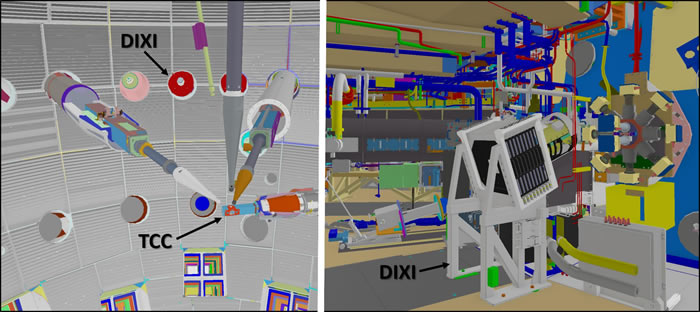 Virtual reality views of the port used by the Dilation X-ray Imager (DIXI) diagnostic and Target Chamber center (TCC) from inside the roomy chamber (left) and of DIXI in the crowded Target Bay outside. Credit: Paul Bloom
Virtual reality views of the port used by the Dilation X-ray Imager (DIXI) diagnostic and Target Chamber center (TCC) from inside the roomy chamber (left) and of DIXI in the crowded Target Bay outside. Credit: Paul Bloom In the Target Bay outside the chamber, however, things look a lot different. It’s a very crowded place. And NIF’s high shot rate and wide-ranging experiments only promise to add to the growing congestion. Aside from the laser ports, the Target Chamber has 126 ports available for diagnostics and DIMs, of which about 96 are currently in use, with more diagnostics on the way.
When an experiment requires a new diagnostic, it can be challenging not just to find an open port, but to find one with enough room for the diagnostic (see “Promising New X-ray Diagnostic Poses Logistics Challenges”). That’s when switching from VR to augmented reality (AR) helps provide a virtual solution to a real-world problem.
Paul Bloom, a mechanical designer spearheading NIF’s Virtual Immersion Engineering (VIE) group, maintains the NIF visualization model that represents the entire facility down to the system level, such as a diagnostic. Evolved from computer aided design (CAD) drawings, exterior representations of every NIF system have been introduced into the world of VR.
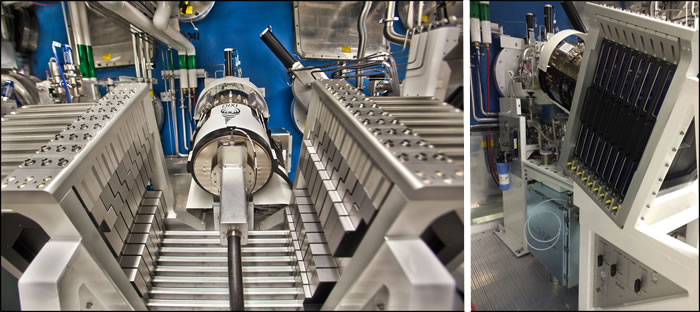 (Above) Attached to the Target Chamber, DIXI, the world’s fastest x-ray framing camera, is shown without shielding (left) and with it. Installation of two more DIXI diagnostics is planned. Credit: Jay Ayers (Below) Computer aided design (CAD) drawings of DIXI without shielding (left) and with it (right). Credit: Paul Bloom
(Above) Attached to the Target Chamber, DIXI, the world’s fastest x-ray framing camera, is shown without shielding (left) and with it. Installation of two more DIXI diagnostics is planned. Credit: Jay Ayers (Below) Computer aided design (CAD) drawings of DIXI without shielding (left) and with it (right). Credit: Paul Bloom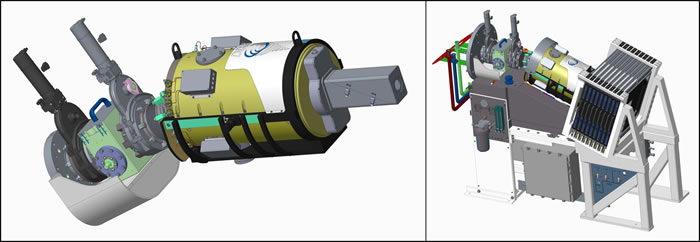
Recently Bloom introduced a VR headset to give users the full immersive experience. “We can wander anywhere within the facility without ever stepping foot inside,” he confirms (see “Crash-proof Virtual Flying Through NIF”).
Through a collaboration with the visualization group in the Lab’s Technical Information Department (TID), Bloom now offers a new AR service that expands on VR to open a new virtual realm.
“For example,” he says, “we can physically go to the Target Bay with an engineer and project a virtual 3D image of a proposed diagnostic onto an available chamber port, or any equipment into the space where it needs to be. The engineer can lock the virtual diagnostic in place and then walk around it as if it were a real object with the same exact size and shape.”
 Composite image representing mechanical engineer Samantha Clements using AR features to evaluate a possible location to install a new DIXI diagnostic. Credit: Jason Laurea and Brian Chavez
Composite image representing mechanical engineer Samantha Clements using AR features to evaluate a possible location to install a new DIXI diagnostic. Credit: Jason Laurea and Brian Chavez Having a view of a piece of equipment in place without ever having to pick up a wrench provides users invaluable answers to questions such as: Will it fit? Is there access to install, operate, and maintain it? Is there enough clearance for it to not interfere with other equipment?
Photographs taken with the AR headset can then be used for proof of acceptable spacing in the design review process. But the potential benefits don’t end there.
Jake Long, a 3D animator in TID’s Visualization Group, understands that the distinctions between realities can be fuzzy for some. “In VR,” he explains, “you typically wear a headset that puts you completely in an artificial world, whether you are in a flight simulator flying an airplane or a video game creeping through caves and caverns. You don’t see anything real around you because it’s all computer generated.
“Using a different headset, AR keeps you in the real, live world,” he says. “If you are in your living room, you can still see your couch and coffee table. But AR overlays 3D imagery on these objects, which interact with you and your actual physical environment through live tracking.”
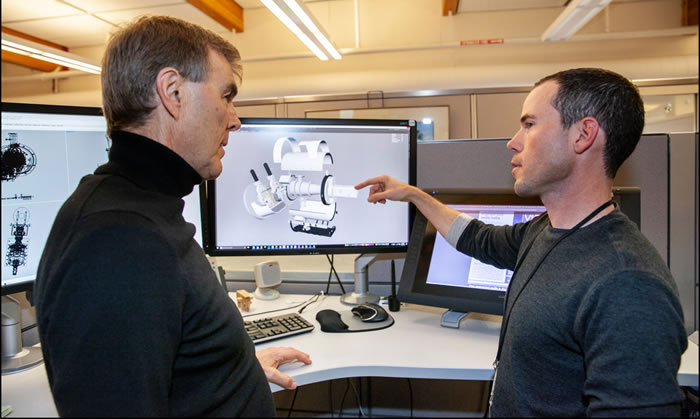 Paul Bloom (left) and Jake Long discuss an animated 3D model that will be uploaded into an AR headset. Credit: Mark Meamber
Paul Bloom (left) and Jake Long discuss an animated 3D model that will be uploaded into an AR headset. Credit: Mark Meamber In 2017, Bloom worked with a team of TID animators to develop a simple AR interactive model of the Target Chamber which uses an electronic tablet for display. It is now used by tour guides to give visitors a better view inside the facility and improved understanding of how NIF works (see “Augmented Reality Captures the ‘Wow’ Factor in NIF Tours”).
He sees the previous work as a critical, yet low-risk, step on the path that led to this new AR approach. Things can now go from virtual to real—and get there fast.
“To use AR to help install a new diagnostic, an engineer would usually provide a CAD model of the proposed design,” says Bloom. “I’d put it into the chamber coordinate system and then strip away structures that would come later in the installation, like shielding for example. Next, I’d pass it over to Jake so that he can prepare it for the AR headset.”
The team currently uses Microsoft’s HoloLens as a headset, which is a fully self-contained computer. Its elaborate sensor array used to scan, map, and track the surroundings includes an inertial measurement unit (for monitoring a user’s movements), ambient light detector, depth-sensing camera, and four “environment understanding” cameras.
Long must optimize the model for it perform smoothly with the headset. “A typical CAD model is very detailed,” he says. “We will eliminate things that you don’t intend to see, then make it more photo-real by adding shading and lighting. Also, it is matched to the environment if needed. Are surfaces brushed aluminum, white plastic, or exposed foam?”
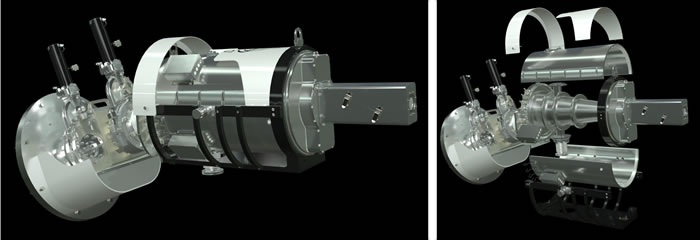 A 3D rendering of DIXI (left) and a 3D exploded view of the diagnostic. Credit: Jake Long
A 3D rendering of DIXI (left) and a 3D exploded view of the diagnostic. Credit: Jake Long For the model to attach to a desired location, Long adds code allowing the headset to recognize a high-contrast and complex pattern used to designate exactly where the model will be virtually bolted down. If you were to step out of sight of the model and return, the model would still be protruding from the exact same spot.
Extra features like model actuations, exploded views, and annotation callouts also can be added through animation. “Using Unity software, we then add triggers and controls to launch the animation. By using hand gestures, you could rotate the model around, or start an animation that would reveal internal components,” Long says.
After Long converts the model into an app that runs on the headset, Bloom is ready to guide users along their journey through the AR world to see their life-sized virtual diagnostic affixed to a chamber port.
Once the spacing checks out and a proposed diagnostic is finalized with the help of AR, Bloom notes, it is not yet time to hang up the headset. Using AR can complement assembly, installation, maintenance, and training by providing virtual sets of step-by-step instructions and diagrams.
With several AR headsets, members of a team can all view the same 3D virtual image located in the correct position. Hand gestures allow members to make annotations that headset video cameras can record, with accompanying narration.
“We are just getting started,” says Bloom, “so we’ll learn much more as we dive deeper. There are vast realities still open to explore.”
—Dan Linehan
Spring Facility Maintenance Period Completed
NIF’s spring Facility Maintenance and Reconfiguration (FM&R) period, which began on March 23, was successfully completed on April 8. More than 150 tasks, including the installation of the Scattered Light Time-history Diagnostic (SLTD) gate valves and first unit, were completed. These new diagnostics will measure scattered light in multiple directions in the Target Chamber during direct-drive experiments.
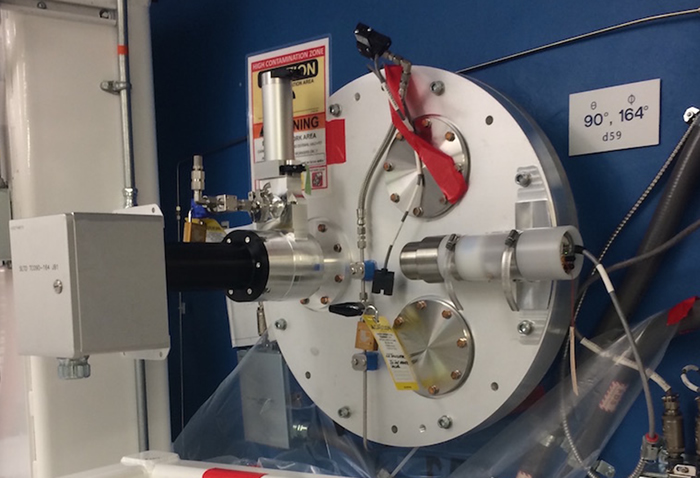 The first Scattered Light Time-history Diagnostic mounted on the NIF Target Chamber.
The first Scattered Light Time-history Diagnostic mounted on the NIF Target Chamber. Other tasks included installation of the gate valve for a third neutron imaging system that will allow imaging from three nearly orthogonal views for 3D reconstruction of neutron images; installation and commissioning of a new Final Optics Damage Inspection System camera called FODI2; and a major Integrated Computer Control System software release and manual regression test.
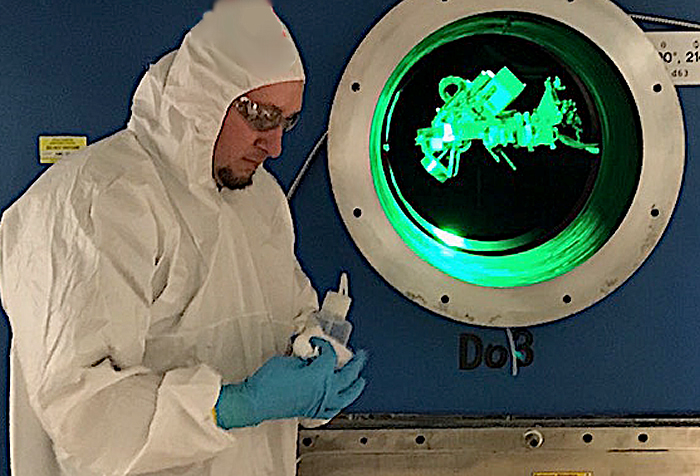 (Above) Nick St. Hilaire of the Target and Handling Team prepares a port for installation of the third neutron imaging system gate valve. The Final Optics Damage Inspection System can be seen through the open port. (Below) Positioner engineer Sam Ahrendes inspects the new cable track installed in a NIF diagnostic instrument manipulator.
(Above) Nick St. Hilaire of the Target and Handling Team prepares a port for installation of the third neutron imaging system gate valve. The Final Optics Damage Inspection System can be seen through the open port. (Below) Positioner engineer Sam Ahrendes inspects the new cable track installed in a NIF diagnostic instrument manipulator.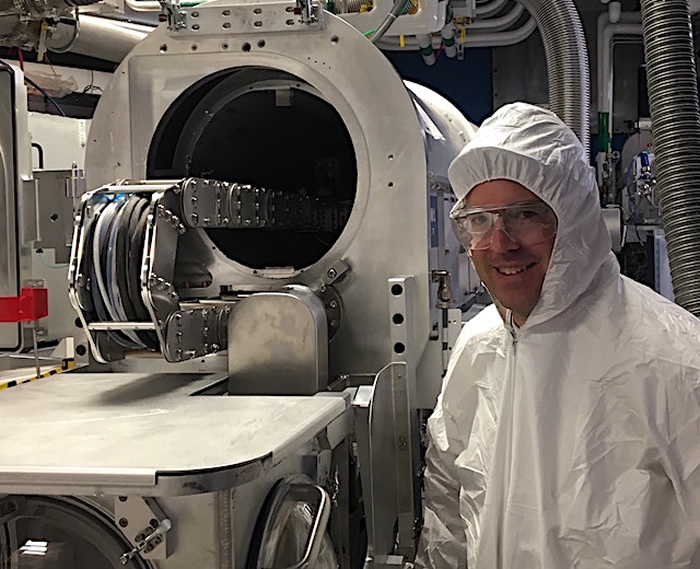
NIF Photos Featured in ‘Art of Science’ Exhibit
LLNL researchers use powerful, state-of-the-art tools, like the National Ignition Facility, to gather scientific detail from every conceivable angle—from larger than life to the atomic scale. Imagery captured from these tools, whether it’s one of the world’s fastest supercomputers or the world’s largest and highest-energy laser, offers a unique interplay between science and art and proves that art is more than paint on canvas, ink on paper, or carved wood or stone.
A new exhibit dubbed “The Art of Science” at Livermore’s Bankhead Theater offers a look at some of that imagery, captured by the Lab’ scientists, engineers, researchers, photographers, and graphic artists. The show takes place in the theater› gallery at 2400 First Street in Livermore.
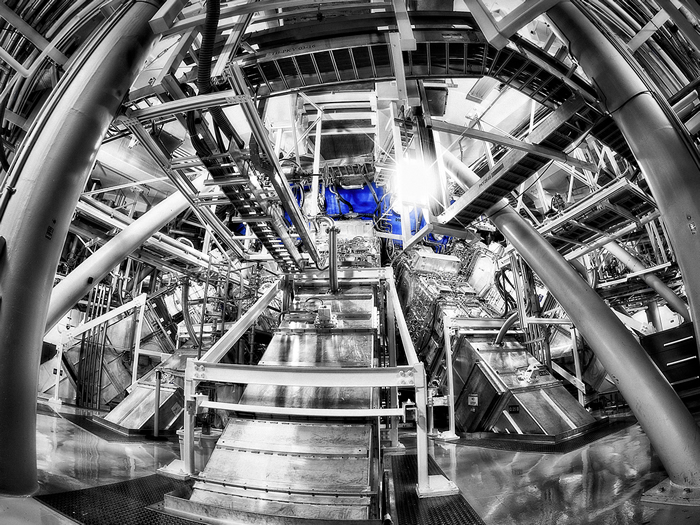 NIF has 192 individual laser beams that come together in the center of the Target Chamber. In this image, several beamlines are shown where they enter the lower hemisphere of the chamber. This is where the laser light is converted from infrared to ultraviolet before being precisely directed into the center of the giant sphere. (Photos by Damien Jemison)
NIF has 192 individual laser beams that come together in the center of the Target Chamber. In this image, several beamlines are shown where they enter the lower hemisphere of the chamber. This is where the laser light is converted from infrared to ultraviolet before being precisely directed into the center of the giant sphere. (Photos by Damien Jemison) Many of the images on display are meant for their technical utility—scientists and engineers use these depictions to answer vital questions that enable the Lab to fulfill its missions in national security, additive manufacturing, high energy density physics, counterterrorism, energy sciences, and more. Yet the works chosen for “The Art of Science” are just as captivating for their aesthetic quality as their scientific detail. The result? Science that is not stodgy, and art that illuminates the path to the future.
 In the NIF capacitor bays, high-voltage capacitors are charged for about 60 seconds before releasing their energy in a 400-microsecond burst to power the flashlamps that energize NIF’ lasers. Peak power for the electrical system exceeds 1 trillion watts, making it the highest-energy and highest-power pulsed electrical system of its kind. There are four capacitor bays at NIF, one on each side of the two laser bays.
In the NIF capacitor bays, high-voltage capacitors are charged for about 60 seconds before releasing their energy in a 400-microsecond burst to power the flashlamps that energize NIF’ lasers. Peak power for the electrical system exceeds 1 trillion watts, making it the highest-energy and highest-power pulsed electrical system of its kind. There are four capacitor bays at NIF, one on each side of the two laser bays. “The Art of Science” will be on display at the Bankhead gallery through April 30. Also on display, in the Founder’s Room just to the left of the lobby, is a collection of intricate 3D photography by the Lab’s Kirk Sylvester, who works as a training coordinator in the Security Organization.
For gallery hours, contact the Bankhead at (925) 373-6800 or visit the Website.
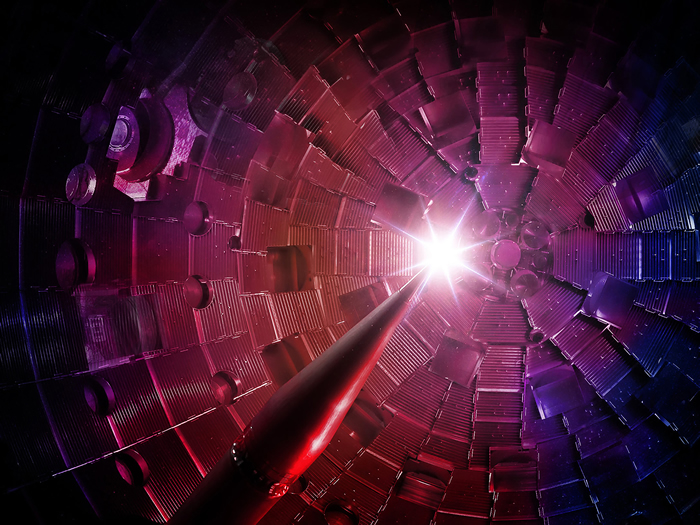 A look inside the NIF Target Chamber shows the target positioner moving into place. Pulses from NIF’s high-powered lasers race through the facility at the speed of light and arrive at the center of the Target Chamber within a few trillionths of a second of each other, aligned to the accuracy of the diameter of a human hair. As the target implodes, temperatures of 100 million degrees and pressures extreme enough to compress the target to densities up to 100 times the density of lead are created. NIF helps ensure the safety and security of the nation’s nuclear weapons stockpile, furthers our understanding of the cosmos, and advances energy research.
A look inside the NIF Target Chamber shows the target positioner moving into place. Pulses from NIF’s high-powered lasers race through the facility at the speed of light and arrive at the center of the Target Chamber within a few trillionths of a second of each other, aligned to the accuracy of the diameter of a human hair. As the target implodes, temperatures of 100 million degrees and pressures extreme enough to compress the target to densities up to 100 times the density of lead are created. NIF helps ensure the safety and security of the nation’s nuclear weapons stockpile, furthers our understanding of the cosmos, and advances energy research. 



